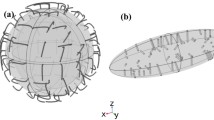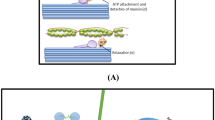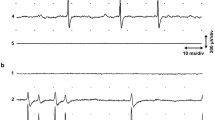Abstract
Fatt and Katz1 demonstrated with the aid of an intracellular microelectrode that the end-plate potential was produced in the region of the motor end-plate by a sudden and transient reduction in the membrane potential as a result of neuromuscular transmitter action. They further pointed out that the prolonged decline of the end-plate potential was almost exponential and was determined by the electrical properties of the resting muscle membrane. An equivalent circuit of the resting muscle membrane is represented as a condenser in parallel with a battery (membrane potential) with a series resistance (membrane resistance). In the active phase of the end-plate potential, the membrane resistance at the junctional region is suddenly reduced by the transmitter action, that is, the muscle membrane is shortened by a shunting resistance1. To demonstrate the active process of the end-plate potential, Takeuchi and Takeuchi2 and Oomura and Tomita3,4 recorded a current flowing through the end-plate region of the muscle membrane by stimulating the nerve under conditions where the membrane potential was kept at the resting level, using the voltage-clamp technique5,6. On the other hand, the small motor nerve fibres which innervate the slow muscle fibres and relate to the tonic function in the maintenance of posture, also produce the junction potential of the small nerve at the junction region by its stimulation7. A distinctive feature of this junction potential is that it displays two phases with a terminal phase of hyperpolarization7. In the present work an attempt has been made to analyse the mechanism of production of the junction potential of the small nerve, using the voltage-clamp technique.
This is a preview of subscription content, access via your institution
Access options
Subscribe to this journal
Receive 51 print issues and online access
$199.00 per year
only $3.90 per issue
Buy this article
- Purchase on SpringerLink
- Instant access to full article PDF
Prices may be subject to local taxes which are calculated during checkout
Similar content being viewed by others
References
Fatt, P., and Katz, B., J. Physiol., 115, 320 (1951).
Takeuchi, N., and Takeuchi, A., J. Neurophysiol., 22, 395 (1959).
Oomura, Y., and Tomita, T., J. Physiol. Soc. Jap., 20, 646 (1958).
Oomura, Y., and Tomita, T., “Electrical Activities of Single Cells”, ed. by Katsuki, Y. (Igakushoin, Tokyo, 1960).
Hodgkin, A. L., and Huxley, A. F., J. Physiol., 116, 424 (1952).
Tasaki, I., and Hagiwara, S., J. Gen. Physiol., 40, 859 (1957).
Kuffler, S. W., and Vaughan Williams, E. M., J. Physiol., 121, 289 (1953).
Burke, W., and Ginsborg, B. L., J. Physiol., 132, 586 (1956).
Author information
Authors and Affiliations
Rights and permissions
About this article
Cite this article
OOMURA, Y., TOMITA, T. Analysis of the Junction Potential of a Small Nerve. Nature 188, 416–417 (1960). https://doi.org/10.1038/188416a0
Issue date:
DOI: https://doi.org/10.1038/188416a0



